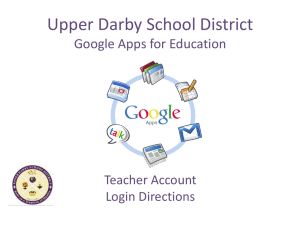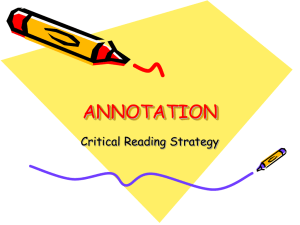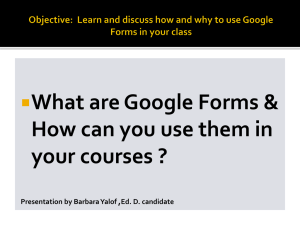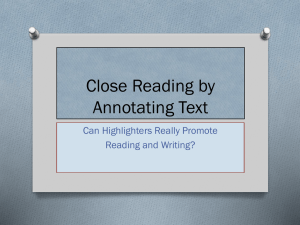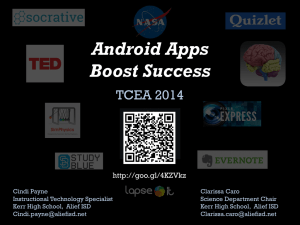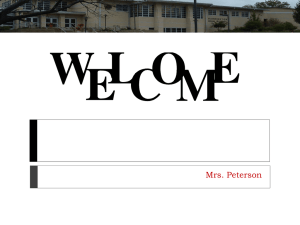Expository Reading and Writing Strategies
advertisement
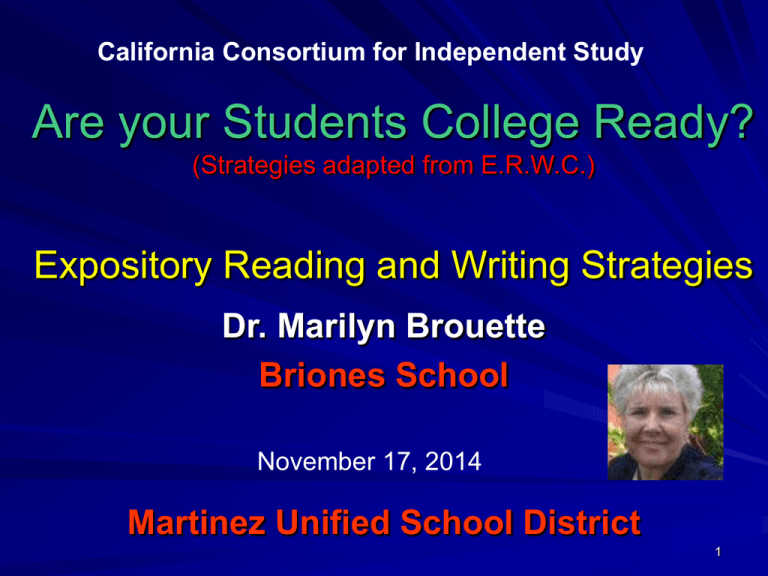
California Consortium for Independent Study Are your Students College Ready? (Strategies adapted from E.R.W.C.) Expository Reading and Writing Strategies Dr. Marilyn Brouette Briones School November 17, 2014 Martinez Unified School District 1 PURPOSE OF PRESENTATION Review Common Core ELA Shifts Share Rhetorical Reading Strategies Highlighting Annotating Marginal Notes Present Strategies through guided practice with informational text Support strategies with Google Apps 2 ELA COMMON CORE SHIFTS Build knowledge through content-rich nonfiction Read, write and speak citing evidence from text, both literary and informational Comprehend complex text Use and understand academic language 3 MEET THE COMMON CORE CHALLENGE Focus on informational text Consider text-based evidence, argument and critical thinking Analyze complex text Integrate academic language 4 DEMONSTRATE INDEPDENDENCE Build strong content knowledge Respond to audience, task, purpose, and discipline Comprehend and critique Value evidence Use technology and digital media 5 RHETORICAL READING Highlighting – Annotating - Marginal Notes Three active reading strategies that ask you to think and make decisions as you read 6 HIGHLIGHTING TIPS Important passages Names of people Unfamiliar vocabulary Quotable lines Key research, statistics & facts Themes & main ideas 7 READING WITH PURPOSE: ANNOTATION GET COLLEGE READY WITH CLOSE READING 8 ANNOTATION GUIDE Number the paragraphs Common Core standards require students to cite and refer to the text Number the paragraphs to facilitate this task. 9 ANNOTATION SHORT HAND ? = Question or unsure of meaning * = Important [ ] = Quotable # = Info, statistic or research ___= New vocabulary 10 MAKING NOTES IN MARGINS Write definitions Ask questions Translate ideas into your own words Capture emotional reactions Make connections… other books, classes, life experiences Summarize Comment on ideas Predict what will happen 11 READING STRATEGY Chunk the text Break up the text into smaller chunks. Draw a horizontal line between the introduction, body paragraphs and conclusion. Ask the student to justify the “chunks.” 12 Read with Purpose Circle Key Terms – Words that are defined – Terms that are repeated throughout the text Names of sources Power verbs Figurative language 13 WHAT DOES THE AUTHOR SAY? Summarize each chunk in the left margin. The chunking allows the student to look at the text in smaller segments and summarize what the author is saying. 14 RECORD YOUR THINKING Write brief summary notes to emphasize points made in graphics Write brief answers to your questions in the margins. Make a brief outline of the material in the margins. Summarize important points in your own words in the margins. State the CONCLUSION in your own words at the end of the article. Write “Conclusion” in the margin. 15 WHAT IS THE AUTHOR DOING? In the right margin, describe what the author is doing. Use power verbs, such as describing, illustrating, arguing, etc. Represent the information with a picture Dig deeper into the text to analyze connections 16 STEPS FOR MARKING A TEXT Tech Twist: Use Google Comment 1. Preview 2. Read 3. Determine author’s purpose 4. Determine the topic 5. Determine the pattern of organization 6. Determine the main idea 7. Go back and mark the text 17 GUIDED PRACTICE ANNOTATING –Article: “If you want to go to college, learn to Fail” 1. What is the topic of this article? 2. How is the article structured? 3. Why did the author write the article? 4. What is the most important point about the article? 18 CHUNK THE TEXT Introduction What is the author’s purpose? 19 Body Paragraphs Cite evidence the author uses to prove his assertion 20 CONCLUSION What emotion does the author appeal to (pathos)? 21 WANT TO GET TO COLLEGE? LEARN TO FAIL! Want to Get Into College? Learn to Fail Education Week, February 1, 2012 By Angel B. Pérez Genre: Commentary Pair Share: Prediction – What is the author’s purpose? 1 I ask every student I interview for admission to my institution, Pitzer College, the same question, “What do you look forward to the most in college?” I was stunned and delighted recently when a student sat across from me at a Starbucks in New York City and replied, “I look forward to the possibility of failure.” Of course, this is not how most students respond to the question when sitting before the person who can make decisions about their academic futures, but this young man took a risk. 22 WANT TO GET TO COLLEGE? LEARN TO FAIL! Pair Share: Whose perspective is addressed? 2 “You see, my parents have never let me fail,” he said. “When I want to take a chance at something, they remind me it’s not a safe route to take. Taking a more rigorous course or trying an activity I may not succeed in, they tell me, will ruin my chances at college admission. Even the sacrifice of staying up late to do something unrelated to school, they see as a risk to my academic work and college success.” 23 UseUseGoogle Comments for annotation Google Document Comments for annotation 24 Google Tech Apps Tech Tool Diigo https://www.diigo.com Notability (apple store) http://www.gingerlabs.com Thinglink https://www.thinglink.com Use/Purpose Annotate, highlight, create post-its, and make a library of sources for any internet website. Add to browser and annotate as you read online. Digitally annotate, great for close-readings Add annotations, photos, videos to pictures 25 Google Tech Apps Tech Tool Use/Purpose Skitch Digital annotation: An http://evernote.com/skitch/ arrow for pointing things out, a text tool, rectangle ?utm_source=interspire you can surround objects with, a highlighter, a "pixelizer" for blurring out details, and a crop tool. Easel.ly http://www.easel.ly Infographic Maker Infotopio http://www.infotopia.info Google powered source for student research 26 Google Tech Apps Tech Tool Mindmup https://www.mindmup.com Use/Purpose Create mind maps and graphic organizers Readability https://www.readability.com Unclutters webpages for easier reading Awesome Screenshot Capture the screen http://awesomescreenshot.com and annotate, crop it, etc. 27 REVIEW Presentation included: Common Core ELA Shifts Rhetorical Reading Strategies Highlighting Annotating Marginal Notes Guided practice with informational text Google Apps 28 Contact Information Dr. Marilyn Brouette Briones School mbrouette@martinez.k12.ca.us (925) 338-5800 ext. 3884 Thank you for your kind attention. Special Thanks to C.S.U. E.R.W.C. for permission to use the article “Want to Get into College, Learn to Fail.” 29
